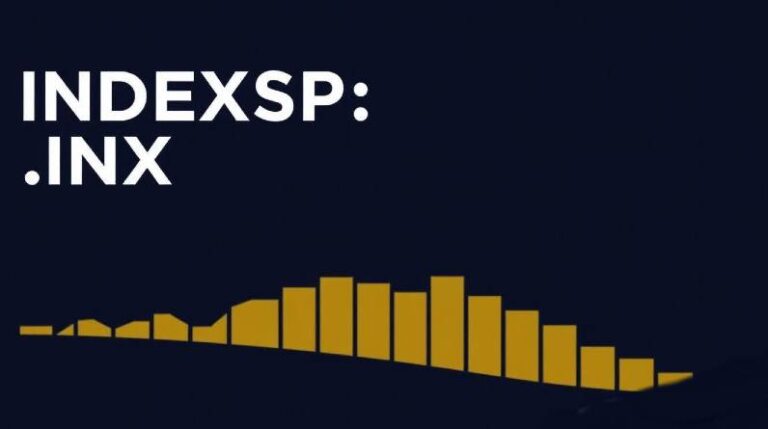INDEXSP: .INX, commonly known as the S&P 500 Index, is often described as the pulse of the U.S. equity market. Comprising 500 of the largest U.S.-listed companies, it is a key benchmark for investors, analysts, and economists worldwide. However, beneath its familiar surface lies a web of intricate dynamics and evolving trends that deserve a more nuanced examination.
This article offers a fresh and insightful perspective on the INDEXSP: .INX, going beyond the conventional narrative to unpack its biases, structural complexities, real-world applications, and changing relevance in today’s markets.
What is INDEXSP: .INX?
INDEXSP: .INX represents the S&P 500 Index, a market-capitalization-weighted index maintained by S&P Dow Jones Indices. It includes 500 large-cap U.S. companies across various sectors, covering approximately 80% of the total U.S. market capitalization.
Key Features:
- Free-float adjustment: Only considers shares available to the public.
- Quarterly rebalancing: Updates the index composition four times a year.
- Diversified sector exposure: Though skewed toward technology, it includes all major industries.
Why INDEXSP: .INX Is Not as Neutral as It Seems
While the S&P 500 is praised for its breadth, a closer look reveals structural biases that challenge its objectivity.
1. Concentration Risk: The Big Tech Domination
Despite including 500 companies, the index is heavily weighted toward a handful of tech giants:
| Company | Approx. Weight in Index (%) |
| Apple (AAPL) | 7.0% |
| Microsoft (MSFT) | 6.8% |
| Amazon (AMZN) | 3.3% |
| Nvidia (NVDA) | 2.9% |
| Alphabet (GOOGL) | 2.7% |
Together, the top 10 companies represent nearly 30% of the entire index, leaving the remaining 490 companies with only 70% of the weight. This undermines the perception of broad diversification.
2. Sectoral Imbalance
The rise of tech stocks has skewed sector weights. As of early 2025:
- Information Technology: ~28%
- Health Care: ~13%
- Financials: ~11%
- Consumer Discretionary: ~10%
This imbalance can cause investor portfolios to be unintentionally overweighted in technology, increasing vulnerability during sector-specific downturns.
Market-Cap vs. Equal-Weight: Which Reflects Reality?
Market-Cap Weighting:
This is the default method for INDEXSP: .INX, giving more influence to larger companies.
Pros:
- Reflects real-world capital flows.
- Favors companies with strong investor backing.
Cons:
- Creates concentration bias.
- Underrepresents small and mid-cap dynamics.
Equal-Weight Alternative:
In an equal-weight S&P 500, each company gets the same influence (0.2%).
Impact Example:
During a year when megacaps underperform and smaller firms excel, the equal-weight index often outperforms the market-cap weighted version, offering a better picture of general economic health.
Total Return vs. Price Index: The Hidden Returns
Many investors look only at the index price when evaluating performance. This is misleading.
- S&P 500 Price Index: Reflects only stock price movements.
- S&P 500 Total Return Index: Includes dividends, showing real investor gains.
Example:
| Year | Price Return | Total Return |
| 2023 | +13.5% | +16.1% |
| 2022 | -18.1% | -16.3% |
By ignoring dividends, investors underestimate long-term wealth accumulation.
Investment Vehicles Tracking INDEXSP: .INX
INDEXSP: .INX is not just an abstract metric—it powers trillions in investment assets.
Popular Investment Products:
- SPDR S&P 500 ETF (SPY)
- Vanguard S&P 500 ETF (VOO)
- iShares Core S&P 500 ETF (IVV)
These funds allow everyday investors to gain exposure to the index with ease and efficiency.
INDEXSP: .INX as a Strategic Tool for Investors
1. Benchmarking Tool
It serves as a standard to measure performance of active portfolios, funds, and sectors.
2. Economic Barometer
A strong S&P 500 typically signals investor confidence in future growth.
3. Risk Management Framework
Using beta, correlation, and volatility of INDEXSP: .INX, portfolio managers assess and hedge market risk.
Technical Analysis in Action
Technical analysts use INDEXSP: .INX to identify entry and exit points:
Common Techniques:
- Moving Averages (50-day, 200-day)
- Relative Strength Index (RSI)
- Fibonacci Retracements
- Volume Spikes
Example: A golden cross (50-day MA crossing above 200-day MA) on the S&P 500 often signals a bullish trend.
A Fresh Perspective: Globalization and ESG Shaping the S&P 500
As globalization and sustainability grow in relevance, the index is adapting:
1. Global Revenue Streams
Many S&P 500 companies earn more than 40% of revenue outside the U.S., making the index a proxy for global corporate health—not just U.S. economics.
2. ESG Integration
New derivative products and index variants increasingly consider Environmental, Social, and Governance (ESG) factors.
ESG-based S&P 500 versions:
- S&P 500 ESG Index
- S&P 500 Fossil Fuel Free Index
These adaptations are attracting socially responsible investors without drastically altering core performance metrics.
Common Misconceptions
Myth 1: “It represents all U.S. stocks.”
Reality: It covers large-cap stocks, not small- or mid-cap sectors, which are represented by other indices like the Russell 2000.
Myth 2: “It guarantees diversification.”
Reality: Sector and company concentration may expose portfolios to similar risks.
Myth 3: “Record highs mean buy more.”
Reality: Record index levels don’t account for valuation metrics or forward-looking returns. Be cautious of momentum bias.
Key Takeaways
1. INDEXSP: .INX Represents the S&P 500 Index
INDEXSP: .INX is the symbol for the Standard & Poor’s 500 Index, one of the most important benchmarks in the global financial market. It tracks 500 of the largest publicly traded U.S. companies, covering around 80% of total U.S. market capitalization.
2. The Index Is Market-Cap Weighted, Not Equal
The index gives greater weight to larger companies, especially tech giants like Apple, Microsoft, and Amazon. This means that while 500 companies are included, the performance is disproportionately influenced by just a few.
3. Tech Megacaps Introduce Concentration Risk
Despite its perceived diversification, over 25% of the index is composed of tech stocks, and the top 10 companies make up nearly 30% of its value. This introduces sectoral and stock-specific risk, especially during tech downturns.
4. Dividends Are Not Reflected in Index Price
The standard S&P 500 index price does not include dividends, which typically average around 2%. Investors should refer to the S&P 500 Total Return Index for a more accurate representation of long-term gains.
5. INDEXSP: .INX Is a Benchmark for Investors
From hedge funds to retail portfolios, the S&P 500 is used as a performance benchmark, helping investors measure their gains or losses relative to the broader market.
6. Powerful Risk Analysis Tool
With its beta, volatility, and historical behavior, INDEXSP: .INX plays a critical role in portfolio risk management, allowing for effective hedging and diversification strategies.
7. Supports a Wide Range of Investment Products
INDEXSP: .INX underlies popular investment vehicles like SPY, VOO, and IVV ETFs, as well as futures, options, and mutual funds, making it accessible to a global investor base.
8. It’s a Global, Not Just U.S., Indicator
Over 40% of S&P 500 company revenues come from international markets, meaning the index reflects not only U.S. economic trends but also global business conditions.
9. Evolving with ESG and Modern Investor Priorities
New variations of the S&P 500, such as ESG-focused indices, are emerging to align with socially responsible investing trends, without deviating significantly from core performance.
10. Record Highs Can Be Misleading
A new peak in INDEXSP: .INX does not automatically mean it’s a good time to invest. Factors like valuation, macroeconomic context, and interest rates must also be considered.
Conclusion: Reframing How We View INDEXSP: .INX
INDEXSP: .INX is more than a financial metric—it’s a barometer of economic sentiment, a cornerstone of passive investing, and a reflection of corporate America’s evolving landscape. But to rely on it without understanding its biases, structure, and real-world implications is a missed opportunity for informed investing.
As the market evolves—driven by tech, global events, and ESG standards—so too must our perspective on the S&P 500. Investors who look beyond the surface will find that INDEXSP: .INX holds not just answers, but powerful questions for the future of investing.
Frequently Asked Questions (FAQs)
1. What does INDEXSP: .INX stand for?
INDEXSP: .INX is the ticker symbol for the S&P 500 Index, which tracks the stock performance of 500 large companies listed on U.S. stock exchanges.
2. Is the S&P 500 a good indicator of the U.S. economy?
Yes, it is widely considered a strong indicator of the U.S. economy because it includes companies across all major sectors and accounts for roughly 80% of U.S. market capitalization. However, it’s important to note the influence of large-cap tech firms, which can sometimes skew its performance.
3. How is the S&P 500 Index calculated?
The index is market-capitalization-weighted and float-adjusted, meaning companies with larger market values and more publicly available shares have a greater impact on the index’s performance.
4. What are the top sectors in INDEXSP: .INX?
As of 2025, the top sectors include:
- Information Technology (~28%)
- Healthcare
- Financials
- Consumer Discretionary
These sector weights change over time due to market performance and quarterly rebalancing.
5. Can I invest directly in INDEXSP: .INX?
You cannot invest in the index itself, but you can invest in index funds or ETFs that track it—such as SPY, VOO, or IVV. These products mirror the index’s performance.
6. What’s the difference between the S&P 500 Price Index and the Total Return Index?
The Price Index reflects only price movements, while the Total Return Index includes dividends reinvested. For long-term performance analysis, the total return offers a more complete picture.
7. Is the S&P 500 overexposed to tech stocks?
Yes, the index is currently heavily weighted toward tech, with the top five companies—Apple, Microsoft, Amazon, Nvidia, and Alphabet—accounting for a significant portion of the total index value. This introduces concentration risk.
8. How often is INDEXSP: .INX updated?
The index is rebalanced quarterly, meaning its component stocks and their weights are reviewed and adjusted four times a year.
9. Does the S&P 500 include small-cap companies?
No, it only includes large-cap companies. Investors interested in small-cap exposure often look at the Russell 2000 Index.
10. Why is INDEXSP: .INX important for global investors?
Many companies in the S&P 500 generate significant revenue internationally. As such, the index is not only a reflection of the U.S. economy but also a proxy for global business performance.
For more insightful articles and the latest updates, keep visiting Hacoo.

